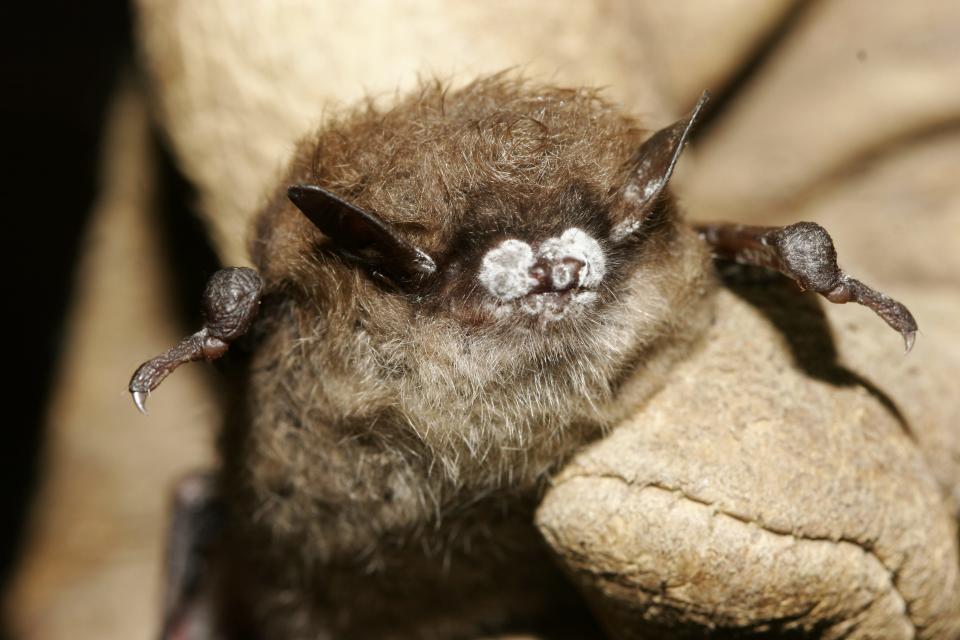Deadly fungus causing white nose syndrome spreads to bats in Carlsbad Caverns
A deadly fungus that’s killed millions of bats nationwide was found in Carlsbad Caverns National Park, where hundreds of thousands of bats roost every year amid the iconic caves and underground landforms.
Samples testing positive for the fungus Pseudogymnoascus destructans (Pd), which causes white nose syndrome, were take in early May from Myotis bats in the Left Hand Tunnel area of Carlsbad Cavern near the Rattlesnake Springs day use area, read an announcement from the National Park Service.
In response Carlsbad Caverns National Park said it was increasing efforts to stem the spread of the fungus into other areas of the cave system by decontaminating caving and research equipment, along with visitor footwear before and after entry.
What is white nose syndrome?
The fungus grows on the faces and wings of hibernating bats, irritating their skin and causing them to awaken and subsequently use up fat reserves and die of starvation during the winter.
It’s named for the visible signs that appear during the later stages of the disease, appearing as a white substance collecting on the bats’ muzzles, wings and bodies. While white nose syndrome is not dangerous to people, though humans can be spread it from one cave to another on clothing and other carried items.
How many bats could be at risk in Carlsbad Caverns?
Carlsbad Caverns National Park hosts 17 bat species, with the largest colony made up of Brazilian free-tailed bats known by visitors for their visible out flights through the natural entrance to the cave every spring through fall.
Park officials estimated the free-tailed bat colony numbered as high as 400,000 in 2005, increasing to 793,000 bats during spring and fall migration.
The park also hosts eastern red bats and hoary bats, which roost in trees, and canyon bats that roost on rock cliffs and in cracks.
Where was it most recently found in southeast New Mexico?
Swabs from bats collected April 29 at Lincoln National Forest, in the Guadalupe Ranger District in the southeast region of New Mexico, tested positive for the fungus.
That sample was taken from the forest’s Cottonwood Cave in Eddy County, the first time in the county or on U.S. Forest Service lands, after employees noticed several bats showing symptoms. They sent samples to the U.S. Geological Survey’s National Wildlife Health Center which produced the positive test results.
Last year, white nose syndrome was found on lands managed by the Bureau of Land Management in Lincoln and DeBaca counties.
White nose syndrome already in 40 U.S. states
The disease has spread through North America since 2006, and it was estimated to kill millions of bats in eastern states, causing especially high mortality rates in hibernation colonies.
It can kill all of the bats in a colony from one infection spread during hibernation, read a report from the Washington Department of Fish and Wildlife. Today, officials estimated the disease is present in 40 U.S. states and eight Canadian provinces.

What was being done to slow the spread of white nose syndrome?
Precautions to stem the spread began at Lincoln National Forest in 2010. Those entering caves were asked to apply for a special permit, and equipment is decontaminated before and after entry.
At Carlsbad Caverns, a “bio-cleaning” mat was installed at entrances to the cave. Visitors walk over the mat which decontaminates and removes potential spores on their shoes.
Officials also asked people to never touch bats, and report dead bats to the local agency.
Any caving gear used in a cave known to have white nose syndrome present should not be used in a cave that is free of the fungus.
Adrian Hedden can be reached at 575-628-5516, achedden@currentargus.com or @AdrianHedden on the social media platform X.
This article originally appeared on Carlsbad Current-Argus: Bats in Carlsbad Caverns suffering from white nose syndrome

